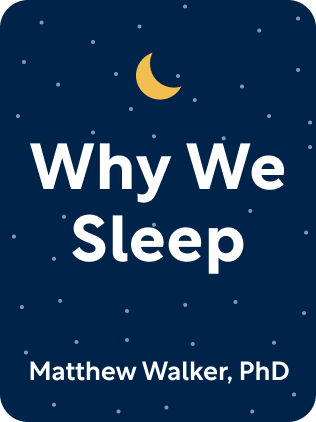

This article is an excerpt from the Shortform summary of "Why We Sleep" by Matthew Walker. Shortform has the world's best summaries of books you should be reading.
Like this article? Sign up for a free trial here .
What is your sleep rhythm? How does it work, and why does it matter?
Your sleep rhythm is the pattern your brain follows while you’re sleeping that controls your stage of sleep: REM or NREM. Your sleep rhythm effects the quality of your sleep, and can have consequences if it’s disrupted.
What Is Sleep Rhythm and How Does it Work?
Sleep is universal in animals, even in insects and worms, despite its apparent drawbacks (vulnerability to predators, loss of time for productivity). When a biological feature is preserved deep in evolutionary history, it is usually a critical function.
How Sleep Rhythm Works
Sleep rhythm is regulated by two mechanisms:
- The circadian rhythm in humans, regulated by melatonin (produced by the suprachiasmatic nucleus in the brain). Think of this as a natural “wake drive,” making you stay awake during the day and waning during night.
- The circadian rhythm responds to light and darkness to calibrate itself. It’s naturally 14 hours and 15 minutes long on average.
- Adenosine is a fatigue signal and causes “sleep pressure.” This rises consistently through the day without sleep, making you feel more tired. Sleeping depletes adenosine, and you wake up with a lower level.
These two mechanisms interact as shown in this graph:
Notice that sleep naturally happens when the difference between curves is greatest – you feel the greatest sleep pressure from adenosine, and the least “wake drive” from your circadian rhythm.
This explains an odd phenomenon: if you’ve ever had to pull an all-nighter, you might have noticed yourself getting a second wind in the morning, oddly feeling more awake at 8AM than at 3AM. This happens because the circadian rhythm in humans “wake drive” is starting up again, and reduces the adenosine-circadian cycle gap.
Circadian rhythms vary from person to person, depending on when they naturally wake up and have maximum energy. The idea of “morning people” and “night owls” is real.
- Whether you’re a morning or night person strongly depends on your genetics.
- Why would humans evolve with this variation? Evolutionarily, having a mixture of morning people and night owls allows a population to reduce its vulnerability in nighttime to a shorter period of time.
- Example: As morning people sleep earlier (say at 10PM), night owls can keep up the watch. Then as night owls get tired (say around 4AM), the morning people are starting to wake.
- But in modern times, the night owls are heavily punished, since early work times force night owls to sleep and wake up earlier than they would naturally prefer. This reduces performance in the mornings. Furthermore, by the time night owls peak in the afternoon, the work day has already ended.
Sleep Cycles Within a Night
Now you understand how your sleep rhythm gives you a regular schedule of sleep from night to night. Next, we’ll look into how, within a single night of sleep, your brain cycles between different types of phases of sleep. This is important to understanding the function of sleep for your brain.
In summary, your circadian cycle causes your brain to switch between two types of sleep – REM (rapid eye movement) and non-REM (NREM) sleep. The two types of sleep have different functions – simplistically:
- NREM clears out old memories and mental “trash,” and moves information into long-term storage.
- REM strengthens the valuable connections that remain, and it forges creative novel connections.
In total for a single night, there’s about an 80/20 split between NREM/REM sleep.
When you sleep, your brain goes through sleep cycles that each last about 90 minutes. Each sleep cycle generally begins with NREM sleep, then ends with REM sleep. As one cycle ends, the next begins. You can see this in a sleep graph here:
How Sleep Cycles Change Through the Night
The circadian rhythm in humans changes throughout the night. Notice that not all sleep cycles look the same. As the sleep progresses through the night, a greater fraction of each cycle is spent in REM sleep.
Why would the circadian cycle be unbalanced in this way? Why not just have all sleep cycles look the same, with 80% in NREM and 20% in REM?
The author hypothesizes that it’s like making a sculpture out of a mass of clay. Earlier in the night, more NREM is needed to clear out junk memories that aren’t useful anymore. Then once only the useful stuff remains, REM strengthens what’s left.
(Shortform note: One way to think about this is that an animal might be interrupted in the middle of the night. So if an animal could only sleep 3 hours in one night, it’d make sense for the more critical functions to be performed first, with the later functions being a luxury if the animal could sleep a full night. This may suggest that NREM performs a more vital function for survival.)
Also beware of what this means for cutting your sleep short. If you normally sleep 8 hours, and one night you have to cut sleep to 6 hours, then you’re not just losing 25% of sleep – you might be losing 60-90% of your REM sleep!
Likewise, going to sleep later than usual might cut short your NREM sleep.
Your sleep rhythm can be hard to control, especially in a busy life. But it’s important to have a consistent sleep rhythm for your health and well being.

———End of Preview———
Like what you just read? Read the rest of the world's best summary of Matthew Walker's "Why We Sleep" at Shortform .
Here's what you'll find in our full Why We Sleep summary :
- Why you need way more sleep than you're currently getting
- How your brain rejuvenates itself during sleep, and why nothing can substitute for sleep
- The 11-item checklist to get more restful sleep today






